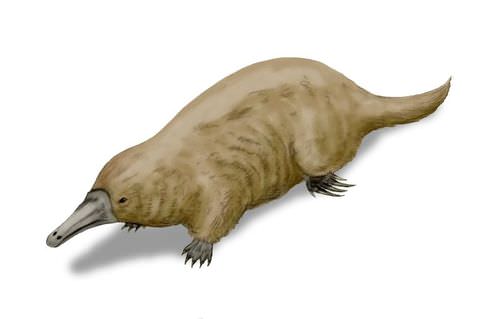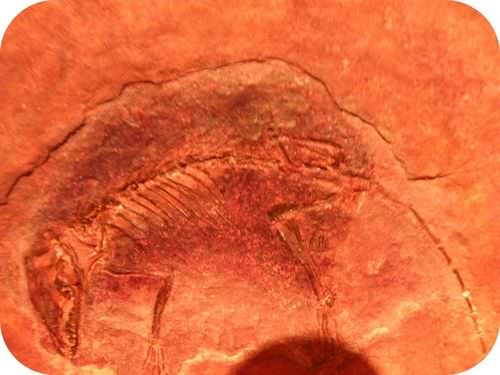12.25: Mammal Evolution
- Page ID
- 13260
\( \newcommand{\vecs}[1]{\overset { \scriptstyle \rightharpoonup} {\mathbf{#1}} } \)
\( \newcommand{\vecd}[1]{\overset{-\!-\!\rightharpoonup}{\vphantom{a}\smash {#1}}} \)
\( \newcommand{\dsum}{\displaystyle\sum\limits} \)
\( \newcommand{\dint}{\displaystyle\int\limits} \)
\( \newcommand{\dlim}{\displaystyle\lim\limits} \)
\( \newcommand{\id}{\mathrm{id}}\) \( \newcommand{\Span}{\mathrm{span}}\)
( \newcommand{\kernel}{\mathrm{null}\,}\) \( \newcommand{\range}{\mathrm{range}\,}\)
\( \newcommand{\RealPart}{\mathrm{Re}}\) \( \newcommand{\ImaginaryPart}{\mathrm{Im}}\)
\( \newcommand{\Argument}{\mathrm{Arg}}\) \( \newcommand{\norm}[1]{\| #1 \|}\)
\( \newcommand{\inner}[2]{\langle #1, #2 \rangle}\)
\( \newcommand{\Span}{\mathrm{span}}\)
\( \newcommand{\id}{\mathrm{id}}\)
\( \newcommand{\Span}{\mathrm{span}}\)
\( \newcommand{\kernel}{\mathrm{null}\,}\)
\( \newcommand{\range}{\mathrm{range}\,}\)
\( \newcommand{\RealPart}{\mathrm{Re}}\)
\( \newcommand{\ImaginaryPart}{\mathrm{Im}}\)
\( \newcommand{\Argument}{\mathrm{Arg}}\)
\( \newcommand{\norm}[1]{\| #1 \|}\)
\( \newcommand{\inner}[2]{\langle #1, #2 \rangle}\)
\( \newcommand{\Span}{\mathrm{span}}\) \( \newcommand{\AA}{\unicode[.8,0]{x212B}}\)
\( \newcommand{\vectorA}[1]{\vec{#1}} % arrow\)
\( \newcommand{\vectorAt}[1]{\vec{\text{#1}}} % arrow\)
\( \newcommand{\vectorB}[1]{\overset { \scriptstyle \rightharpoonup} {\mathbf{#1}} } \)
\( \newcommand{\vectorC}[1]{\textbf{#1}} \)
\( \newcommand{\vectorD}[1]{\overrightarrow{#1}} \)
\( \newcommand{\vectorDt}[1]{\overrightarrow{\text{#1}}} \)
\( \newcommand{\vectE}[1]{\overset{-\!-\!\rightharpoonup}{\vphantom{a}\smash{\mathbf {#1}}}} \)
\( \newcommand{\vecs}[1]{\overset { \scriptstyle \rightharpoonup} {\mathbf{#1}} } \)
\( \newcommand{\vecd}[1]{\overset{-\!-\!\rightharpoonup}{\vphantom{a}\smash {#1}}} \)
\(\newcommand{\avec}{\mathbf a}\) \(\newcommand{\bvec}{\mathbf b}\) \(\newcommand{\cvec}{\mathbf c}\) \(\newcommand{\dvec}{\mathbf d}\) \(\newcommand{\dtil}{\widetilde{\mathbf d}}\) \(\newcommand{\evec}{\mathbf e}\) \(\newcommand{\fvec}{\mathbf f}\) \(\newcommand{\nvec}{\mathbf n}\) \(\newcommand{\pvec}{\mathbf p}\) \(\newcommand{\qvec}{\mathbf q}\) \(\newcommand{\svec}{\mathbf s}\) \(\newcommand{\tvec}{\mathbf t}\) \(\newcommand{\uvec}{\mathbf u}\) \(\newcommand{\vvec}{\mathbf v}\) \(\newcommand{\wvec}{\mathbf w}\) \(\newcommand{\xvec}{\mathbf x}\) \(\newcommand{\yvec}{\mathbf y}\) \(\newcommand{\zvec}{\mathbf z}\) \(\newcommand{\rvec}{\mathbf r}\) \(\newcommand{\mvec}{\mathbf m}\) \(\newcommand{\zerovec}{\mathbf 0}\) \(\newcommand{\onevec}{\mathbf 1}\) \(\newcommand{\real}{\mathbb R}\) \(\newcommand{\twovec}[2]{\left[\begin{array}{r}#1 \\ #2 \end{array}\right]}\) \(\newcommand{\ctwovec}[2]{\left[\begin{array}{c}#1 \\ #2 \end{array}\right]}\) \(\newcommand{\threevec}[3]{\left[\begin{array}{r}#1 \\ #2 \\ #3 \end{array}\right]}\) \(\newcommand{\cthreevec}[3]{\left[\begin{array}{c}#1 \\ #2 \\ #3 \end{array}\right]}\) \(\newcommand{\fourvec}[4]{\left[\begin{array}{r}#1 \\ #2 \\ #3 \\ #4 \end{array}\right]}\) \(\newcommand{\cfourvec}[4]{\left[\begin{array}{c}#1 \\ #2 \\ #3 \\ #4 \end{array}\right]}\) \(\newcommand{\fivevec}[5]{\left[\begin{array}{r}#1 \\ #2 \\ #3 \\ #4 \\ #5 \\ \end{array}\right]}\) \(\newcommand{\cfivevec}[5]{\left[\begin{array}{c}#1 \\ #2 \\ #3 \\ #4 \\ #5 \\ \end{array}\right]}\) \(\newcommand{\mattwo}[4]{\left[\begin{array}{rr}#1 \amp #2 \\ #3 \amp #4 \\ \end{array}\right]}\) \(\newcommand{\laspan}[1]{\text{Span}\{#1\}}\) \(\newcommand{\bcal}{\cal B}\) \(\newcommand{\ccal}{\cal C}\) \(\newcommand{\scal}{\cal S}\) \(\newcommand{\wcal}{\cal W}\) \(\newcommand{\ecal}{\cal E}\) \(\newcommand{\coords}[2]{\left\{#1\right\}_{#2}}\) \(\newcommand{\gray}[1]{\color{gray}{#1}}\) \(\newcommand{\lgray}[1]{\color{lightgray}{#1}}\) \(\newcommand{\rank}{\operatorname{rank}}\) \(\newcommand{\row}{\text{Row}}\) \(\newcommand{\col}{\text{Col}}\) \(\renewcommand{\row}{\text{Row}}\) \(\newcommand{\nul}{\text{Nul}}\) \(\newcommand{\var}{\text{Var}}\) \(\newcommand{\corr}{\text{corr}}\) \(\newcommand{\len}[1]{\left|#1\right|}\) \(\newcommand{\bbar}{\overline{\bvec}}\) \(\newcommand{\bhat}{\widehat{\bvec}}\) \(\newcommand{\bperp}{\bvec^\perp}\) \(\newcommand{\xhat}{\widehat{\xvec}}\) \(\newcommand{\vhat}{\widehat{\vvec}}\) \(\newcommand{\uhat}{\widehat{\uvec}}\) \(\newcommand{\what}{\widehat{\wvec}}\) \(\newcommand{\Sighat}{\widehat{\Sigma}}\) \(\newcommand{\lt}{<}\) \(\newcommand{\gt}{>}\) \(\newcommand{\amp}{&}\) \(\definecolor{fillinmathshade}{gray}{0.9}\)
Could you argue that the duckbilled platypus has some characteristics of other species?
Like a bird or a fish? You could. This might suggest that an ancestor of this species may have been one of the early mammals to evolve.
Evolution of Early Mammals
The earliest mammals evolved from cynodonts. But the evolution of mammals didn’t end there. Mammals continued to evolve. Monotreme mammals probably split off from other mammals first. They were followed by marsupials. Placental mammals probably evolved last.
Evolution of Monotremes
The first monotremes may have evolved about 150 million years ago. Early monotreme fossils have been found in Australia. An example is a genus called Steropodon, shown in Figure below. It may have been the ancestor of the platypus. Early monotremes retained some of the traits of their therapsid ancestors. For example, they laid eggs and had a cloaca. These traits are still found in modern monotremes.
 Probable Monotreme Ancestor: Steropodon. Like the platypus, Steropodon probably had a bill.
Probable Monotreme Ancestor: Steropodon. Like the platypus, Steropodon probably had a bill.Evolution of Marsupials
The first marsupials may have evolved about 130 million years ago. One of the earliest was the extinct genus Sinodelphys. Sinodelphys was about 15 centimeters (6 inches) long. Its limb structure suggests that it was a climbing animal. It could escape from predators by climbing into trees. It probably lived on a diet of insects and worms.
Evolution of Placental Mammals
The earliest placental mammals may have evolved about 110 million years ago. The ancestor of placental mammals may be the extinct genus Eomaia. Fossils of Eomaia have been found in what is now China. It was only about 10 centimeters (4 inches) long. It was a tree climber and probably ate insects and worms. Eomaia had several traits of placental mammals. Figure below shows how Eomaia may have looked.
 Probable Ancestor of Placental Mammals: Eomaia. Eomaia lived a little over 100 million years ago.
Probable Ancestor of Placental Mammals: Eomaia. Eomaia lived a little over 100 million years ago.The placental mammal descendants of Eomaia were generally more successful than marsupials and monotremes. On most continents, placental mammals became the dominant mammals, while marsupials and monotremes died out. Marsupials remained the most common and diverse mammals in Australia. The reason for their success there is not yet resolved.
Evolution of Modern Mammals
The Cretaceous Period ended with another mass extinction. This occurred about 65 million years ago. All of the dinosaurs went extinct at that time. Did the extinction of the dinosaurs allow mammals to take over?
Traditional View
Scientists have long assumed that the extinction of the dinosaurs opened up many niches for mammals to exploit. Presumably, this led to an explosion of new species of mammals early in Cenozoic Era. Few mammalian fossils from the early Cenozoic have been found to support this theory. Even so, it was still widely accepted until recently.
View from the Mammalian Supertree
In 2007, an international team of scientists compared the DNA of almost all known species of living mammals. They used the data to create a supertree of mammalian evolution. The supertree shows that placental mammals started to diversify as early as 95 million years ago.
What explains the diversification of mammals long before the dinosaurs went extinct? What else was happening at that time? One change was a drop in Earth’s temperature. This may have favored endothermic mammals over ectothermic dinosaurs. Flowering plants were also spreading at that time. They may have provided new and plentiful foods for small mammals or their insect prey.
The supertree also shows that another major diversification of mammals occurred about 50 million years ago. Again, worldwide climate change may have been one reason. This time Earth’s temperature rose. The warmer temperature led to a greater diversity of plants. This would have meant more food for mammals or their prey.
Summary
- Monotremes evolved about 150 million years ago. Like modern monotremes, they had a cloaca and laid eggs.
- Marsupials evolved about 130 million years ago. They were very small and ate insects and worms.
- Placental mammals evolved about 110 million years ago. They were also small and climbed trees.
- Placental mammals became the dominant land mammals. Most marsupials and monotremes died out, except in Australia.
- The mammalian supertree shows that placental mammals started to diversify as early as 95 million years ago.
Review
- Outline the evolution of monotreme, marsupial, and placental mammals.
- Describe Sinodelphys.
- Describe Eomaia.
- What is the mammalian supertree?
- Explain why the extinction of most therapsids may have allowed mammals to evolve.
- What explains the diversification of mammals long before the dinosaurs went extinct?
| Image | Reference | Attributions |
 |
[Figure 1] | License: CC BY-NC |
 |
[Figure 2] | Credit: Nobu Tamura Source: commons.wikimedia.org/wiki/File:Steropodon_BW.jpg License: CC BY 3.0 |
 |
[Figure 3] | Credit: Flickr:emf1947 Source: www.flickr.com/photos/emf1947/6827785264/ License: CC BY 2.0 |

